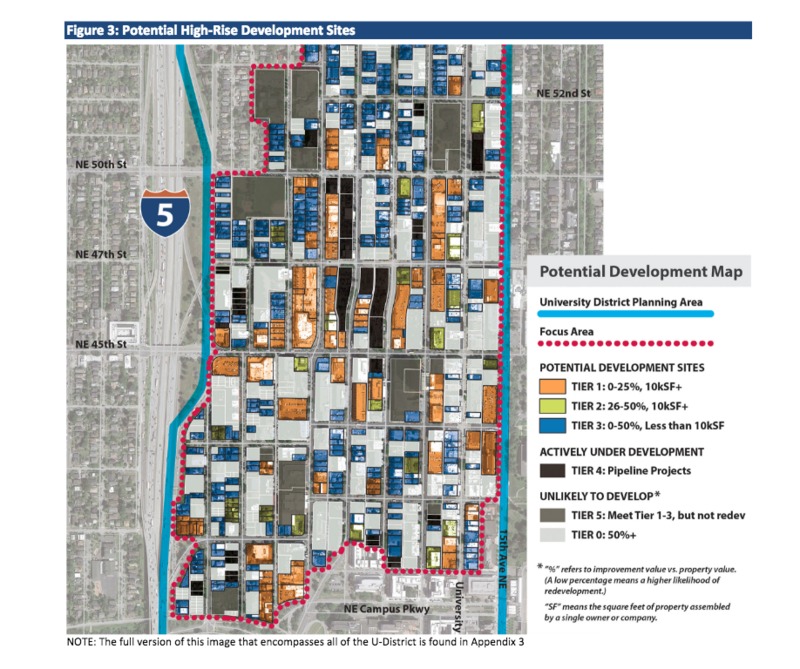Site Report #4: The Past and Future U District

Two pie charts displaying the restaurant breakdown of the University District. Shows the relative homogeneity of the restaurants on the Ave catering to students. U-District Retail Study and Strategy.

Map of the potential high-rise development sites of the University District. U-District Urban Design Framework.
The University District is the neighborhood next to and connected to the University of Washington. Anchored by the University of Washington campus, the University District is a hub for college students. However, The Seattle Times reports that the Seattle City Council plans to make the U-District into the next high-rise neighborhood in their approval of a massive up-zone (Beekman 1). The article writes that "the legislation raises maximum heights, allowing buildings to climb to 320 feet on some blocks near a light-rail station opening in 2021" (Beekman 1). The City of Seattle not only sees a need for increased density because of the growing University of Washington, but also sees the U-District as a future area for business. They see potential for a diversified economy that relies less on small “mom and pop” shops and more on corporations and “high rise” businesses. This would pop the educational/residential bubble of the U-District converting it to a business center. With the close proximity to a large, well-funded research university, in the eyes of the City the U-District has the potential to become a center for innovation. However, changing the composition of the neighborhood would not only pull people in, but it may push people out. Although the legislation requires the construction and inclusion of affordable housing in the project, critics worry that the new upzone will push out poorer renters. Supporters of the new legislation argue that "upzone would help the U District absorb more residents and jobs, sensibly concentrating growth near the University of Washington and light rail" (Beekman 1). Nonetheless, the upzone will undoubtedly change the culture of the U-District.
Today, all aspects of the neighborhood target university students on a budget, and rightfully so. According to the University District Residential Market Analysis of 2013, in 2012 40% of the area population was between the ages of 20 and 24 and 21% were between the ages of 25 and 34. As a result, apartments comprise over 75% of the housing stock in the University District and half of the residential properties are used as rental properties with 45% of townhouses and 41% of condo units used as rental properties (City of Seattle DPD 21-23). Compared to other neighborhoods in Seattle, rent in the University District is cheaper in order to compete with dorm prices and attract student renters. Similarly, restaurants are also catered toward university students. Out of all the restaurants on “The Ave” 64% are fast-food restaurants and 54% of these restaurants are of the Asian cuisine creating a fairly homogeneous commercial makeup (Downtown Works LLC 19). The façade of the University District is generally dirty, run-down, and unsightly. In a qualitative assessment of the district, 50% of operations scored below standards for their quality and condition (Downtown Works LLC 21). This façade creates an environment that is perceived as unsafe. If it could be improved, the perceived increase in safety would attract more families, young adults, and businesses thus diversifying the University District and benefiting the many students for whom the University District is already their neighborhood.
In the University Community Urban Center Approval and Adoption Matrix from 1998, the University Community Urban Center outlines a plan that addresses this issue of safety throughout the University District and specifically on this block (between 7th Ave NE and 8th Ave NE, and NE 45th St and NE 43rd St). This block is a residential block that includes multiple apartment buildings largely occupied by University of Washington students. These students walk from these apartment buildings to campus everyday through an area that is generally unlit and not very safe. To address this issue, the City plans to designate NE 43rd St as a “green street” or “key pedestrian street” from I-5 to the university campus (UCUC 6). The City will “install pedestrian bulbs and other amenities where possible” to improve the safety of the area for students walking (UCUC 24). It will also “add a pedestrian crossing at NE 45th St and 8th Ave NE” that will greatly improve the walk for students specifically travelling to this block (UCUC 24-25). This block has always been a residential block, and these plans improve the environment and the neighborhood for the residents living there, strengthening the block’s residential integrity. According to the UD Residential Market Analysis by Seattle Department of Planning and Development (DPD), in terms of development on this block, there is projected to be potential development on the side of the block closest to 45th St, where there is currently a parking lot. There is projected to be little to no change in the interior of the block and minimal change on the side of the block closest to 43rd St. (City of Seattle DPD, 14). This again reflects the city planner’s intentions of keeping the block a residential, neighborhood block as it has always been.
Ideally, in a student-centered University District, the streets would be well-lit, clean, and active. Rent prices would stay relatively cheap so that students who do not want to live on campus will still be able to find apartments within walking distance. With these improvements, not only will the University District be improved for students, but will also be diversified attracting different businesses and residents to the area. While cleaning up the streets and storefronts of establishments seem like purely aesthetic improvements, these improvements will clean up the culture of the University District, benefitting students, young professionals, and families alike. With the upzoning of the U-District the neighborhood will likely go from being university-centered to business-centered. Although this provides job opportunities for students after graduation it may detract from the neighborhood feel the U-District boasts today.
